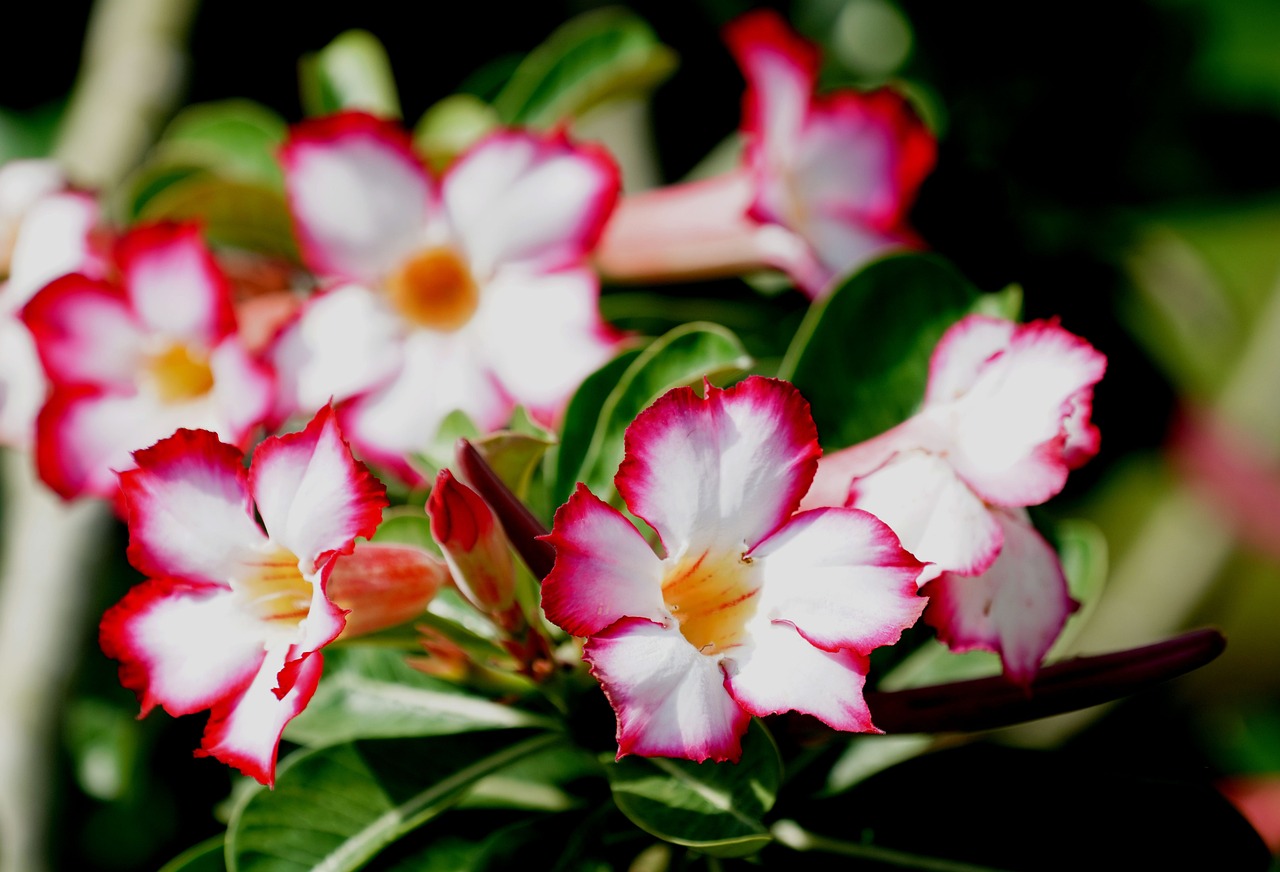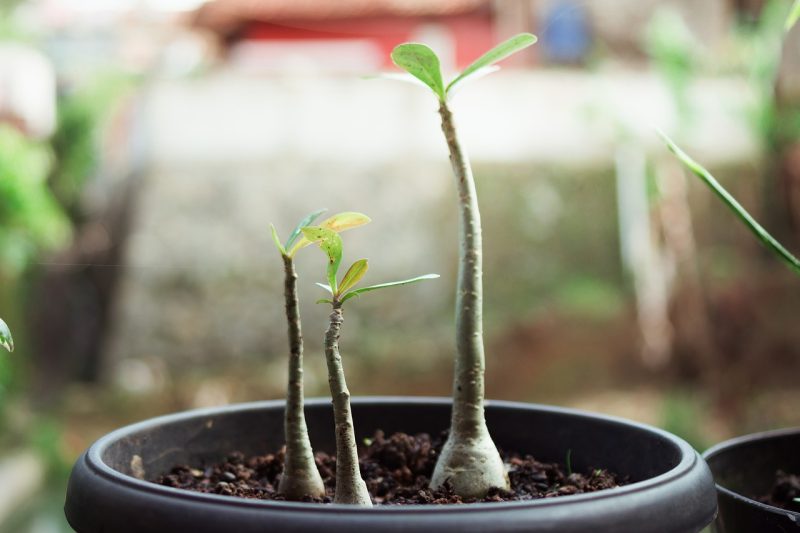This post will provide you with an in-depth guide on how to propagate Adenium obesum successfully.
Understanding Adenium obesum
Before we move on to propagation methods, let’s briefly discuss what makes the Desert Rose special. Native to Africa and the Arabian Peninsula, it is noted for its large, trumpet-shaped flowers that can come in various colors, including pink, red, and white. Its swollen trunk, known as a caudex, is not only visually appealing but also serves as a water reservoir, making it resilient in arid conditions.
Why Propagate Your Desert Rose?
There are several reasons why you might want to propagate your Desert Rose:
Create More Plants:If you love your current Desert Rose, propagating will allow you to cultivate more plants for your home or to share with friends.
Preserve Varieties:If you have a particularly cherished variety, propagation can help ensure it lives on.
Control Growth and Health:By propagating, you can take cuttings from healthier plants or those with desirable traits, improving the overall quality of your collection.
Methods of Propagation
There are two primary methods for propagating Desert Rose:stem cuttings and seeds. Below, we will detail both methods so that you can choose what suits your preferences and circumstances.
1. Propagating from Stem Cuttings
Materials Needed:
A healthy Desert Rose plant
Sharp, clean pruning shears or a knife
Rooting hormone (optional)
Well-draining potting mix (succulent or cactus mix recommended)
Pots or containers
Plastic bag or humidity dome (optional)
Steps:
Select a Cutting:Look for a healthy stem that is at least 6 inches long and has several leaves. Late spring or early summer is the best time to take cuttings as the plant is in its active growth period.
Cut the Stem:Use sharp, sterilized shears to make a clean cut. Cut just below a leaf node to encourage rooting.
Allow to Callus:Let the cutting sit in a dry place for a day or two, allowing the cut end to callus over. This step is crucial as it helps prevent rot when the cutting is placed in soil.
Apply Rooting Hormone (Optional):If you want to boost your chances of successful propagation, dip the callused end of the cutting into rooting hormone.
Plant the Cutting:Fill a pot with well-draining soil and make a hole in the center. Place the cutting in the hole and gently pat the soil around it to secure it in place.
Water and Care:Water the cutting lightly, just enough to settle the soil. Place the pot in a warm, bright spot, but out of direct sunlight. If desired, cover with plastic or a humidity dome to retain moisture.
Monitor and Maintain:Keep the soil slightly moist but never soggy. After a few weeks, gently tug on the cutting. If there’s resistance, roots have likely formed.
Transplant:Once roots have developed, you can transplant the new plant into a larger pot.
2. Propagating from Seeds
Materials Needed:
Desert Rose seeds
Seed starter mix or well-draining potting soil
Seed trays or small pots
Plastic wrap or humidity dome
Steps:
Prepare Soil:Fill your seed trays or pots with seed starter mix. Ensure it is moist but not soggy.
Sow Seeds:Scatter the seeds lightly on top of the soil. Use a fine layer of soil to gently cover them, or you can leave them uncovered as Adenium seeds can germinate with light exposure.
Water Gently:Mist the soil surface to ensure it’s evenly moist without displacing the seeds.
Create Humidity:Cover the tray or pot with plastic wrap or a humidity dome to create a greenhouse effect. This helps maintain moisture and warmth.
Provide Light:Place your seed trays in a warm, bright location that receives indirect sunlight.
Germination:Seeds should germinate within 2 to 4 weeks. Remove the plastic wrap as soon as you see green sprouts to prevent mold.
Thinning Seedlings:Once the seedlings have a couple of sets of true leaves, thin them out if they are overcrowded to allow for healthy growth.
Transplant:Once seedlings are big enough to handle, transplant them into individual pots to allow for proper growth and development.
Tips for Successful Propagation
For the best results when propagating your Desert Rose, consider the following tips:
Humidity and Temperature:Adenium obesum thrives in warm conditions. Ideal temperatures range between 70°F and 90°F (21°C to 32°C). If you’re using a humidity dome or plastic wrap, ensure there’s still airflow to prevent mold growth while maintaining moisture.
Light Requirements:Once the cuttings or seedlings establish roots, they will benefit from bright but indirect sunlight. Too much direct sunlight can scorch the young plants, while too little can hinder their growth.
Watering Practices:It’s important to allow the soil to dry out slightly between waterings. Desert Roses are succulents and prefer to be on the drier side. Overwatering can lead to root rot, especially in young plants.
Fertilization:After a couple of months of growth, consider fertilizing your new plants with a diluted succulent fertilizer. This can encourage robust growth and healthier blooms when they mature.
Common Issues and Solutions
While propagating Desert Roses is relatively straightforward, you may encounter a few challenges. Here are some common issues and how to address them:
Cuttings Not Rooting:If your stem cuttings are not rooting after several weeks, it may be due to excess moisture or a lack of warmth. Ensure you’re allowing the soil to dry out between waterings and maintain a warm environment.
Seedlings Wilting:Wilting can indicate insufficient moisture or too much direct sunlight. Adjust your watering schedule and consider relocating your seedlings to a spot with less direct light.
Pest Problems:Keep an eye out for common pests like aphids or mealybugs, which can affect the health of your cuttings. If you notice pests, treat them promptly with insecticidal soap or a neem oil solution.
Conclusion
Propagating Desert Rose (Adenium obesum) can be a rewarding endeavor, whether you’re looking to expand your plant collection or simply want to keep your favorites thriving. By following the methods outlined above and keeping an eye on your plants’ needs, you’ll be well on your way to cultivating a beautiful array of Desert Roses in your home or garden.
Don’t hesitate to share your propagation journey on platforms like Pinterest, where the plant community thrives on shared experiences and tips! Whether you’re showcasing your cuttings, seedlings, or full-grown plants, there’s no doubt that your Desert Rose will spark admiration and curiosity among fellow plant lovers.







